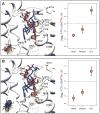Parallel molecular evolution in an herbivore community
- PMID: 23019645
- PMCID: PMC3770729
- DOI: 10.1126/science.1226630
Parallel molecular evolution in an herbivore community
Abstract
Numerous insects have independently evolved the ability to feed on plants that produce toxic secondary compounds called cardenolides and can sequester these compounds for use in their defense. We surveyed the protein target for cardenolides, the alpha subunit of the sodium pump, Na(+),K(+)-ATPase (ATPα), in 14 species that feed on cardenolide-producing plants and 15 outgroups spanning three insect orders. Despite the large number of potential targets for modulating cardenolide sensitivity, amino acid substitutions associated with host-plant specialization are highly clustered, with many parallel substitutions. Additionally, we document four independent duplications of ATPα with convergent tissue-specific expression patterns. We find that unique substitutions are disproportionately associated with recent duplications relative to parallel substitutions. Together, these findings support the hypothesis that adaptation tends to take evolutionary paths that minimize negative pleiotropy.
Figures



References
-
- Crow JF. Annu Rev Genet. 2008;42:1. - PubMed
-
- Kimura M. The Neutral Theory of Molecular Evolution. Cambridge Univ. Press; Cambridge: 1983.
-
- Carroll SB. Cell. 2008;134:25. - PubMed
-
- Stern DL. Evolution, Development, and the Predictable Genome. Roberts and Company Publishers; Greenwood Village, CO: 2011.
-
- Wright S. Evolution and the Genetics of Populations. Univ. of Chicago Press; Chicago: 1968. pp. 1–4.
Publication types
MeSH terms
Substances
Associated data
- Actions
- Actions
- Actions
- Actions
- Actions
- Actions
- Actions
- Actions
- Actions
- Actions
- Actions
- Actions
- Actions
- Actions
- Actions
- Actions
- Actions
- Actions
- Actions
- Actions
- Actions
- Actions
- Actions
- Actions
- Actions
- Actions
- Actions
- Actions
- Actions
- Actions
- Actions
- Actions
Grants and funding
LinkOut - more resources
Full Text Sources
Other Literature Sources

